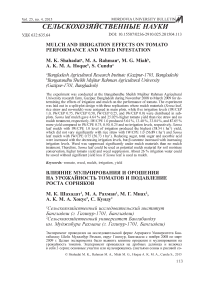Mulch and irrigation effects on tomato performance and weed infestation
Автор: Shahadat M.K., Rahman M.A., Miah M.G., Hoque A. K. M. A., Cundu S.
Журнал: Инженерные технологии и системы @vestnik-mrsu
Рубрика: Сельскохозяйственные науки
Статья в выпуске: 4, 2015 года.
Бесплатный доступ
The experiment was conducted at the Bangabandhu Sheikh Mujibur Rahman Agricultural University research farm, Gazipur, Bangladesh during November 2008 to March 2009 for determining the effects of irrigation and mulch on the performance of tomato. The experiment was laid out in a split-plot design with three replications where mulch materials (Senna leaf, rice straw and no-mulch) were assigned in main plots, while five irrigation levels (IW/CEP 1.0, IW/CEP 0.75, IW/CEP 0.50, IW/CEP 0.25, and IW/CEP 0.0) were distributed in subplots. Senna leaf mulch gave 4.64 % and 25.02% higher tomato yield than rice straw and no mulch treatment, respectively. IW/CPE 1.0 produced 5.64 %, 13.40 %, 33.04 %, and 87.65 % more yield compared to IW/CPE 0.75, 0.50, 0.25 and no irrigation levels, respectively. Senna leaf mulch with IW/CPE 1.0 level of irrigation produced the highest (58.54 t ha -1) yield, which did not vary significantly with rice straw with IW/CPE 1.0 (56.89 t ha -1) and Senna leaf mulch with IW/CPE 0.75 (56.73 t ha -1). Reducing sugar, total sugar and ascorbic acid were increased with the decreasing irrigation levels, but в carotene increased with increasing irrigation levels. Weed was suppressed significantly under mulch materials than no mulch treatment. Therefore, Senna leaf could be used as potential mulch material for soil moisture conservation, higher tomato yield and weed suppression. About 26 % irrigation water could be saved without significant yield loss if Senna leaf is used as mulch.
Tomato, weed, mulch, irrigation, yield
Короткий адрес: https://sciup.org/14720183
IDR: 14720183 | DOI: 10.15507/0236-2910.025.201504.113
Список литературы Mulch and irrigation effects on tomato performance and weed infestation
- Ahamed T. 2003. Effect of different light levels on growth, yield and quality of tomato varieties. M. S. Thesis, Dept. of Agroforestry and Environment, BSMRAU, Gazipur, Bangladesh.
- Rashid M. M. 1993. Sabji Biggyan (in Bengal). First edition, Bangla Academy, Bangladesh. pp. 387-393.
- BBS, 2005. Handbook of Agricultural Statistics, December 2005. Bangladesh Bureau of Statistics, People's Republic of Bangladesh.
- FAO Production of Year Book of 1987. Basic data unit. Rome, Italy. p. 179.
- Ali M., Alam Z., Akanda A. M. 1994. Grafting-A Technique to Oontrol Soil-Borne Disease of Tomato and Eggplant. IPSA-JAIKA Project Publication No. 4. IPSA, Gazipur, Bangladesh.
- Begum M. N.1999. Effects of irrigation and phosphorus on the yield and quality in tomato (Lycopersicon esculentum Mill.). M. S. Thesis. BSMRAU, Gazipur, Bangladesh.
- Begum M. N., Rahman A. J. M. S., Egashira K. 2001. Effect of irrigation and application of phosphorus fertilizer on the yield and water use of tomato grown on a clay terrace soil of Bangladesh. Journal of the Faculty of Agriculture. Kyushu University 45(2): 611-619.
- Bose T. K., Som M. G. 1986. Vegetable crops in India. B. Mitra Naya Prokash, Bidhan Sarani, Oalcutta, India.
- Doroenbas M., Kassam A. H. 1979. Yield response to water. FAO Irri. Drain. Pp. 33. Rome.
- Jones H. G. 2004. Irrigation scheduling: Advantages and Pitfalls of Plant-based Methods. Journal of Experimental Botany 55(407): 2427-2436.
- Ossom E. M., Pace P. F., R. L. Rhykerd R. L, Rhycard O. L. 2001. Effect of mulch on weed infestation, soil temperature, nutrient concentration and tuber yield in Ipomoea batatus (L.) Lam. In Papua New Guinea. Tropical Agriculture (Trinidad).78: 144-151.
- Ramakrishna A., Tam H. M., Wani S. P., Long T. D. 2006. Effect of mulch on soil temperature, moisture, weed infestation and yield of groundnut in northern Vietnam. Field Orops Research. 95: 115-125.
- Zhang X., Ohen S., Liu M., Pei D., Sun H. 2005. Improved water use efficiency associated with cultivars and agronomic management in the north Ohina plain. Agronomy Journal 97: 783-790.
- Rahman M. J., Uddin M. S., Uddin M. J., Begum S. A., Halder N. K., Hossain M. F. 2004. Effect of different mulches on potato at the saline soil of southern Bangladesh. Journal of Biological Sciences 4(1): 1-4.
- Haque M. S., Islam M. R., Karim M. A. H. 2003. Biomass production and growth rates at different phenophases of garlic as influenced by natural and synthetic mulches. Asian Journal of Plant Sciences 2(1): 90-96.
- Kamara A. Y., Akobundu I. O., Sanginga N., Jutzi S. O. 2000. Effect of mulch from selected multipurpose trees (MPTs) on growth, nitrogen nutrient and yield of maize (Zea mays L.), J. Agronomy and Crop Science. 184: 73-80.
- Anonymous. 1989. Annual Weather Report. IPSA, Meteorological Station. IPSA, Salna. Gazipur. P-2.
- Doring T. F., Brandt M. M., Heb J., Finckh M. R., Saucke H. 2005. Effect of straw mulch on soil nitrate dynamics, weeds, yield and soil erosion in originally grown potatoes. Field Orop Research. 94: 238-249.
- Rahman M. A. 2008. Potential Application of Tree Leaves for Orop Production and Soil Environment Ohange during the Dry Season of Bangladesh. A Dissertation of Doctor of Philosophy. Graduate School of Social and Oultural Studies, Kyushu University, Japan.
- Hasan M. R. 2006. Effect of tree leaves on crop productivity and soil properties at different nitrogen levels. M. S Thesis, Dept. of Agroforestry and Environment, BSMRAU, Gazipur, Bangladesh.
- Ara M. J. F. 2005. Effect of photosysthetically active radiation and moisture regimes on the performance of tomato (Lycopersicon esculentum Mill.). MS Thesis. Dept. of Agroforestry and Environment, BSMRAU, Gazipur, Bangladesh.
- Mohapatro B. K., Lenka D., Naik P. 1998. Effect of plastic mulching on yield and water use efficiency in maize. Ann. Agric. Res. 19(2): 210-211.


